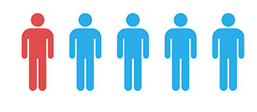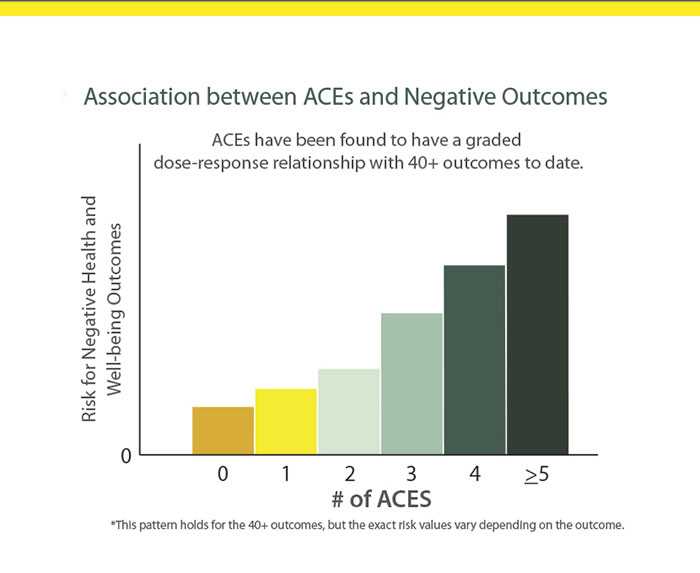About Behavioral Risk Factor Surveillance System ACE Data
Many states are collecting information about Adverse Childhood Experiences (ACEs) through the Behavioral Risk Factor Surveillance System (BRFSS). The BRFSS is an annual, state-based, random-digit-dial telephone survey that collects data from non-institutionalized U.S. adults regarding health conditions and risk factors. Since 2009, a total 32 states plus the District of Columbia have included ACE questions for at least one year on their survey.
States Collecting BRFSS ACE Data by Year, 2009-2014.

Source: Centers for Disease Control and Prevention. Behavioral Risk Factor Surveillance System Survey ACE Data, 2009-2014. Atlanta, Georgia: U.S. Department of Health and Human Services, Centers for Disease Control and Prevention; 2015.
BRFSS ACE Module
The BRFSS Adverse Childhood Experiences (ACE) module was adapted from the original CDC-Kaiser ACE Study and is used to collect information on child abuse and neglect and household challenges. The module is available in English and Spanish.
The questionnaires are not copyrighted, and there are no fees for their use. If you include the ACE Study questionnaires in your research, a copy of the subsequent article(s) is requested (send to dvpinquiries@cdc.gov).
Data and Statistics
Adverse Childhood Experiences (ACEs) are categorized into two groups on the BRFSS ACE module: abuse and family/household challenges. Each category is further divided into multiple subcategories. Neglect items are not included on the BRFSS ACE module.
In 2010, Washington, DC and ten states (HI, ME, NE, NV, OH, PA, UT, VT, WA, and WI) included the optional ACE module on their state survey making it the largest BRFSS ACE data collection year. BRFSS participants’ demographic information is available for 2010 by gender, race, age, and education. Prevalence of individual ACEs from the 2010 BRFSS ACE data is organized by ACE categories.
Note: States that have added the ACE module using their own resources are not required to report ACE data back to CDC BRFSS. To access states’ ACE data please contact each state’s BRFSS coordinator. A list of state coordinators can be found online: https://www.cdc.gov/brfss/state_info/coordinators.htm
ACEs Definitions
All ACE questions refer to the respondent’s first 18 years of life.
- Abuse1
- Emotional abuse: A parent or other adult in your home ever swore at you, insulted you, or put you down.
- Physical abuse: A parent or other adult in your home ever hit, beat, kicked or physically hurt you.
- Sexual abuse: An adult or person at least 5 years older ever touched you in a sexual way, or tried to make you touch their body in a sexual way, or attempted to have sex with you.
- Household Challenges
- Intimate partner violence:2 Parents or adults in home ever slapped, hit, kicked, punched or beat each other up.
- Household substance abuse: A household member was a problem drinker or alcoholic or used street drugs or abused prescription medications.
- Household mental illness: A household member was depressed or mentally ill or a household member attempted suicide.
- Parental separation or divorce: Parents were ever separated or divorced.
- Incarcerated household member: A household member went to prison.
1 Abuse Questions were modified from the original CDC-Kaiser ACE Study to make them more appropriate for a telephone survey.
2 In the original CDC-Kaiser ACE Study, the question pertained only to the mother being treated violently.
Participant Demographics
Demographic information reported below is for Washington, DC and ten states (HI, ME, NE, NV, OH, PA, UT, VT, WA, and WA) that included the ACE module on the 2010 BRFSS (n=53,784).
Demographic Information for Participants Completing the ACE Module on the 2010 BRFSS.
| Demographic Information | Percent (N = 53,784) | |
|---|---|---|
| Gender | ||
| Female | 51.2% | |
| Male | 48.8% | |
| Race/Ethnicity | ||
| White | 85.1% | |
| Hispanic/Latino | 3.7% | |
| Asian/Pacific Islander | 3.2% | |
| African-American | 4.6% | |
| Other | 3.4% | |
| Age (years) | ||
| 18-29 | 13.6% | |
| 30-39 | 20.8% | |
| 40-49 | 21.4% | |
| 50-59 | 18.6% | |
| 60 and over | 25.6% | |
| Education | ||
| Not High School Graduate | 5.6% | |
| High School Graduate | 30.5% | |
| Some College | 26.8% | |
| College Graduate or Higher | 37.1% | |
Note: Reports and articles that use data from other years and/or states may contain different estimates.
Source: Centers for Disease Control and Prevention. Behavioral Risk Factor Surveillance System Survey ACE Module Data, 2010. Atlanta, Georgia: U.S. Department of Health and Human Services, Centers for Disease Control and Prevention; 2015.
ACEs Prevalence
The prevalence estimates reported below are from Washington, DC and ten states (HI, ME, NE, NV, OH, PA, UT, VT, WA, and WI) who included the ACE module on the 2010 BRFSS (n=53,784).
Prevalence of ACEs by Category for Participants Completing the ACE Module on the 2010 BRFSS.
| ACE Category | Women | Men | Total |
|---|---|---|---|
| Percent (N =32,539) | Percent (N =21,245) | Percent (N =53,784) | |
| ABUSE | |||
| Emotional Abuse | 34.1% | 35.9% | 35.0% |
| Physical Abuse | 15.8% | 15.9% | 15.9% |
| Sexual Abuse | 15.2% | 6.4% | 10.9% |
| HOUSEHOLD CHALLENGES | |||
| Intimate Partner Violence | 15.6% | 14.2% | 14.9% |
| Household Substance Abuse | 27.2% | 22.9% | 25.1% |
| Household Mental Illness | 19.3% | 13.3% | 16.3% |
| Parental Separation or Divorce | 23.1% | 22.5% | 22.8% |
| Incarcerated Household Member | 5.2% | 6.2% | 5.7% |
Note: Reports and articles that use data from other years and/or other states may contain different estimates.
ACE Score Prevalence for Participants Completing the ACE Module on the 2010 BRFSS.
| Number of Adverse Childhood Experiences (ACE Score) | Women Percent (N =32,539 ) |
Men Percent (N =21,245) |
Total Percent (N =53,784) |
|---|---|---|---|
| 0 | 40.0% | 41.4% | 40.7% |
| 1 | 22.4% | 24.9% | 23.6% |
| 2 | 13.4% | 13.2% | 13.3% |
| 3 | 8.0% | 8.1% | 8.1% |
| 4 or more | 16.2% | 12.4% | 14.3% |
Note: Reports and articles that use data from other years and/or other states may contain different estimates.
Source: Centers for Disease Control and Prevention. Behavioral Risk Factor Surveillance System Survey ACE Module Data, 2010. Atlanta, Georgia: U.S. Department of Health and Human Services, Centers for Disease Control and Prevention; 2015. Available from https://www.cdc.gov/violenceprevention/acestudy.
Major Findings

Adverse Childhood Experiences (ACEs) are common. ACE data from the BRFSS was similar to that of the original ACE Study. Regardless of the data source, almost two-thirds of surveyed adults report at least one ACE, and more than one in five reported three or more ACEs.
The ACE score, a total sum of the different categories of ACEs reported by participants, is used to assess cumulative childhood stress. Regardless of the data source, study findings repeatedly reveal a graded dose-response relationship between ACEs and negative health and well-being outcomes across the life course.
Dose-response describes the change in an outcome (e.g., alcoholism) associated with differing levels of exposure (or doses) to a stressor (e.g. ACEs). A graded dose-response means that as the dose of the stressor increases the intensity of the outcome also increases.
As the number of ACEs increases so does the risk for the following:
- Myocardial infarction
- Asthma
- Mental distress
- Depression
- Smoking
- Disability
- Reported income
- Unemployment
- Lowered educational attainment
- Coronary heart disease
- Stroke
- Diabetes
*Findings reflect studies that have utilized BRFSS data on various years. This list is not exhaustive. For more outcomes see selected journal publications.
Association between ACEs and Negative Outcomes

- Page last reviewed: April 1, 2016
- Page last updated: April 1, 2016
- Content source:
Error processing SSI file


 ShareCompartir
ShareCompartir
